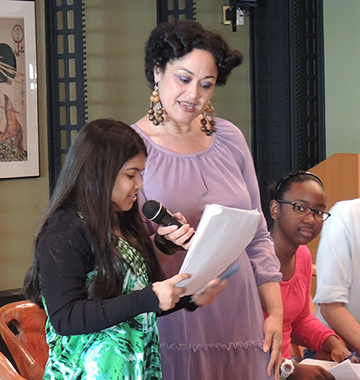Grade(s) taught: 2nd–5th
Genre(s) taught: Short fiction, narrative
Download: A Penny For Your Thoughts
Common Core State Standards:
(Refer to the English Language Arts Standards > Writing > Grade 2, Grade 3, Grade 4, and Grade 5)
- CCSS.ELA-LITERACY.W.2–5.3: Write narratives to develop real or imagined experiences or events using effective technique, descriptive details, and clear event sequences. [NOTE: Exact wording of this standard differs by grade.]
Pennies from the Heavens of Mind and Imagination. When I saw my coin jar overflowing with pennies, it called to mind the saying “a penny for your thoughts,” and gave me an idea for a lesson plan: Take one thought and open up a child’s world.
One of my goals, when I teach writing, is to help my students to become more aware of their thoughts so they realize that writers’ ideas are not magical things that fall out of the sky. Every writing teacher at some point will hear the common student lament, “I don’t have any ideas!” Focusing on meta-cognition—or thinking about thinking—can help educators to engage even young students in the complex process of articulating their thoughts. Those thoughts in turn can become the starting point for creative writing responses and provide students with the motivation for seeing them through. This “penny for your thoughts” exercise is a fun and engaging way to get students thinking about what goes through their minds. Once students have begun to articulate their thoughts, follow-up class discussions can allow them to cross-fertilize these thoughts and experiences with those of their classmates, sparking new ideas and helping students who say they can’t think of anything to write. My students enjoyed sharing thoughts that told stories of their lives and, in the process, learned to think of these stories as material for their writing—all for just a penny.
LESSONS
Lesson 1: Introduction
I started the lesson by telling students: What happens inside your head will be the spark to motivate you as a writer. Your thoughts are ingredients that create writing ideas. I want you to take those thoughts out of your heads and change them into words on paper. Before we start writing, let’s consider a few questions:
- What is thinking?
- What is a thought or an idea?
- How many thoughts do you have in a week?
My fifth-grade students in Brooklyn defined thinking as creating thoughts or ideas in the mind, and said that an idea can be a “mind-picture.” Their responses to the third question were revealing. The highest total from any child was fewer than a hundred thoughts. I used the “penny for your thoughts” lesson to help them see that, in fact, they have an infinite number of thoughts in a week.
(Time: Introduction/10–15 minutes)
Triggering students’ thoughts using the saying “a penny for your thoughts”
I wrote the saying on the board and asked students if they had ever heard of it, knew the meaning, and could tell me how it was used. We agreed that you say the phrase to a person who seems distracted or deep in thought—maybe anxious—when you want him to express what he is thinking at that moment. I explained that it might sound “cheap” to offer so little for someone’s thoughts, but a penny was worth a lot more when the saying originated. Your thoughts were deemed valuable when a person offered money to get at what was on your mind.
I told my students, “When I say ‘a penny for your thoughts,’ please pick up your pencils and write a thought. Your thoughts can be about something real or imagined. Each time I repeat the saying, write a thought. If nothing comes to mind right away, shake a thought loose by searching your mind with your inner eye, or by making something up. Write your thought in one sentence or more. After we do five ‘thought rounds,’ I’ll ask you to read your thoughts aloud. Then we’ll continue with five more rounds of thinking, writing, and reading aloud our thoughts. If you read your thought to us, you get a penny, so you get apenny for your thought.” The novelty of being paid for having a thought didn’t wear off, even for this fifth-grade class. It was a fun incentive that added some pizazz to the school day.
Diagramming penny-thought experiences
I drew simple illustrations on the board to illuminate what we mean when we talk about thoughts and the thought process. The diagrams provided kids with “visual frameworks” to understand what happens when they hear and respond to “a penny for your thoughts.” I quick-sketched the illustrations to the laughter and surprise of the children. [These illustrations can be viewed on Dropbox.]
The first five rounds served as a warm-up. I stopped for discussion after these rounds to make sure that students grasped the aim of the “a penny for your thoughts” prompt: to search with the inner eye to find an idea or to make up an imaginary thought. I invited students to share some of the thoughts they had written. Children who had struggled to conjure thoughts now had a chance to listen to classmates’ ideas as examples. The second five rounds followed the same procedure as the first five: I said “a penny for your thoughts,” students wrote, and then they read their thoughts aloud. Writing down their thoughts heightened students’ awareness of their own thinking processes.
Bonus box for penny-thoughts
After students had practiced writing “penny thoughts,” I set up a bonus box where kids wrote thoughts anonymously if they had free time during the school day. 3” x 5” index cards were placed in the box to facilitate writing. Whenever I had downtime, I read thoughts aloud to the class.
Here are some of my fifth-graders’ thoughts:
- I thought of being a gold ring and giving myself to my mother.
- I thought I was a big man walking. But I said to myself I am not a big man. I am a boy. But every thought came up man, man, man.
- I imagined that I was in a pool drowning and nobody was there to help me. It was very quiet with no noise in the water.
- I thought I was walking in the sky. But while I was walking, somebody woke me up. I felt sad. At night I dreamed I was in the sky. It was beautiful and I felt happy. I looked like an angel flying.
Any hesitancy students had about expressing their thoughts diminished as they began to read them aloud. In many cases they shared personal things, and their classmates listened closely. The lesson spurred students’ imaginations, giving them pleasure and practice in the demanding skill of idea generation, and letting them know that they can generate an infinite number of writing ideas from their minds.
NOTE: Teachers may prefer to collect papers and read students’ thoughts anonymously. For grades 2 and 3, I ask students to write fewer thoughts: three or four per round.
Penny-thoughts as writing prompts
The next step in this lesson is to have the students use the thoughts they have generated in response to the “penny for your thoughts” exercise as writing prompts. Write on the board, “A penny for your thoughts about…” and ask students to expand one thought or a combination of thoughts into an imaginary and/or real-life experience. Sample writing prompts culled from the above thoughts are: Gold Ring, My Mother, Big Man, I Am A Boy, Talking To Myself, Thoughts, Nobody There, Help Me, Very Quiet, Sky Walking, Sadness, Sky Dreams, Angel.
(Time: writing thoughts/20 minutes, reading aloud/15 minutes, writing in response to prompts/15 minutes)
Lesson 2: Introducing discussion questions to expand thoughts and stimulate writing
Part 1: Following the open-ended “pennies” lesson #1, I continued with an inquiry-based approach in which I selected and analyzed students’ thoughts, and then fostered discussion about them through my questioning. In part 1 of lesson #2, I used the same procedure as lesson #1, saying “a penny for your thoughts” as the class reflected and wrote their responses. After 10 rounds of “pennies,” I created discussion questions at home for various provocative thoughts and used them the next day to motivate writing and class discussion.
Part 2: After students had experience putting their thoughts on paper, I turned to an inquiry-based approach in which I selected a few students’ thoughts and brainstormed questions to prompt a lively class discussion and provide a writing assignment. I explained, “Now we are moving to the next part of the ‘a penny for your thoughts’ lesson. We’re going to explore some of the thoughts you have shared to see if we can better understand what you’re thinking, creating, and communicating.”
Here are two examples of student thoughts, the questions I asked the class, and the methods used to help students generate ideas for their written work.
Thought 1: I thought I was a flower, and a little girl took me and kept me forever.
Questions
- Do you visualize or see images of your thoughts? Give an example.
- How can a thought or an image take you on a trip in your imagination? Describe a story created in your head by a thought or an image.
- Is it okay to let your imagination go free at times and just enjoy the ride? Why or why not?
- What mind-pictures do you visualize in the writer’s thought?
- What feelings do the images trigger in you?
- What does the student’s thought get you to think about?
- Visualize the life of the flower and little girl. Can you create a story using the thought as a spark?
Writing Activity
My students’ responses to the above questions began to generate mind-pictures, feelings, and expanded thinking, which inspired them to write stories about the little girl and the flower. To jump-start the writing process, I had students work collaboratively to brainstorm ideas for this story. First, I asked the class to describe what the characters looked like and the images they saw as they imagined the characters in their minds. I then asked questions to help students develop key elements of their stories:
- Where is the flower kept?
- How would you describe what the world looks from the flower’s “eyes” and from the girl’s eyes?
- What happens to the flower and the girl during the day and night?
- What feelings and thoughts do the flower and girl experience?
- What feelings do they communicate to one another?
- How often does the flower see the little girl?
- What “conversations” take place between them?
Thought 2
I was angry with my friend and she was angry with me, too. She walked away and told her mother, and her mother told me to be friends and I said, “Okay,” but I was still mad at her and she was my friend.
Questions
- Why did the student express her angry thought?
- Do you ever have angry thoughts about friends? How do you handle those feelings to calm down?
- What mind-pictures did you visualize connected to the writer’s anger?
- Did the mother help the situation? Explain.
- Why was the writer still mad at the end? What bothered her the most?
- If you were the writer, how would you make peace with your friend?
Discussion
“If you’re friends, the problem shouldn’t happen, but it does all the time,” and with that line I began our class conversation: “Do you argue, get angry, and fight with friends? Why do good friends get mad at each other?” We discussed changing angry, hurt feelings and making peace by applying students’ solutions: “Talk, don’t walk away from the problem.” “Each girl should express her feelings.” I asked, “How should both girls feel after their talk? Why?” And then I added, “Bad feelings that build up, if not dealt with, can hurt or destroy a friendship. How can the girls resolve the anger issues by themselves? What would restore peace to the friendship?”
Writing Activity
I asked students to start to create imaginary scenes between the girls, by:
- Word-storming “angry” and “friend,” thinking of other words that connect to both.
- Picture-storming possible incidents between the girls that might have increased their anger, visualizing and describing events that might have made them angry.
- Sentence-storming descriptions of a peaceful resolution to the friends’ situation.
- Title-storming potential titles for the narrative.
Armed with written ideas for scenes between the two girls, students were ready to craft narratives describing why the characters were angry and how they solved the problem.
Closing
I asked a few students to share the narratives they had written.
(Time: discussing questions/10 minutes, writing/20 minutes, sharing stories/10 minutes)
Final penny-thoughts
These penny lessons provide an easy, fun way to jump-start the writing process, especially when students’ energy levels are running on empty. Giving students time to focus on their thoughts, interrogate them, and share them with others turns up the volume inside their heads. Students appreciate this because their thoughts hold the stories of their lives. This approach gives them a chance to take a voyage into the airy parts of their mind and imagination, tripping through the rich territory of their inner landscapes, which they can then mine for ideas for their writing. All of this for the price of a penny.
Vocabulary:
Cognition, visualization
Multimodal Approaches to Learning:
This lesson incorporates aspects of interpersonal learning during class discussion; intrapersonal learning as students spend time focusing on and writing down their thoughts; and linguistic learning when students write their narratives.
Jeffrey Pflaum has been an elementary school teacher in New York City public schools for 34 years. As a teacher, he created original curricula in writing, creativity, reading, creative thinking, poetry, emotional intelligence, and vocabulary expansion. His educational techniques and approaches culminated in an inspirational book, Motivating Teen and Preteen Readers: How Teachers and Parents Can Lead the Way (Rowman & Littlefield Education, 2011). More recently, Pflaum’s “Contemplation Music Writing Project” will be a chapter in an upcoming pioneering book, Teaching Mindfulness Skills to Kids and Teens, edited by Dr. Christopher Willard and Dr. Amy Saltzman (Guilford Press, September 2015). His students’ poetry is published in magazines, newspapers, and by major commercial book publishers. Learn more about Pflaum’s projects, articles, and samples of student poetry, on his blog.



